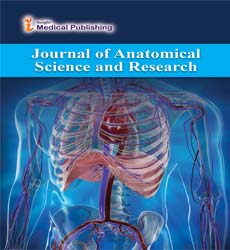Anatomical Study of Accessory Muscles in the Upper Limb and Their Clinical Significance
Priya Nair*
Department of Anatomy, All India Institute of Medical Sciences, New Delhi, India
*Corresponding Author:
Priya Nair,
Department of Anatomy, All India Institute of Medical Sciences, New Delhi, India,
E-mail- priya.nair@mse.in
Received date: February 03, 2025; Accepted date: February 95, 2025; Published date: February 28, 2025
Citation: Nair P (2025) Anatomical Study of Accessory Muscles in the Upper Limb and Their Clinical Significance. J Anat Sci Res Vol: 8 No: 1: 02
Introduction
The upper limb is characterized by remarkable anatomical complexity, facilitating diverse motor functions and dexterity. While the typical muscular anatomy of the arm, forearm, and hand is well described, variations in the form of accessory muscles are frequently encountered. These supernumerary muscles, though often asymptomatic, may present clinically by causing neurovascular compression, confusing radiological diagnosis, or complicating surgical procedures. An understanding of their morphology, frequency, and clinical implications is therefore essential for anatomists, clinicians, and surgeons alike. Accessory muscles in the upper limb arise due to variations in embryological development, where persistence of additional muscle primordia or abnormal splitting of existing muscle masses gives rise to supernumerary structures. Such anomalies may occur at various sites including the arm, forearm, and hand. While most are incidental findings during cadaveric dissection or imaging studies, their presence may become clinically relevant when associated with compressive neuropathies or vascular syndromes [1].
Description
One of the most frequently described accessory muscles is the accessory head of the biceps brachii. This variant typically arises from the humerus or brachialis and joins the main muscle belly before inserting at the radial tuberosity. Although usually asymptomatic, the accessory head can increase muscle bulk, potentially compressing the musculocutaneous nerve or complicating surgical approaches to the anterior arm. Its recognition is important for interpreting MRI or CT scans of the arm. Another well-documented anomaly is the Gantzerâ??s muscle, an accessory head of the flexor pollicis longus or Flexor Digitorum Profundus (FDP). Originating from the medial epicondyle or coronoid process, it courses in close proximity to the anterior interosseous nerve. Hypertrophy or anomalous insertion of this muscle may lead to AIN compression, manifesting as weakness in thumb and index finger flexion [2].
The anconeus epitrochlearis, a rare variant arising from the medial epicondyle and inserting into the olecranon, forms a fibromuscular tunnel over the ulnar nerve at the cubital tunnel. This configuration predisposes individuals to ulnar neuropathy, presenting clinically as numbness, tingling, or weakness in the ulnar distribution of the hand. Surgical decompression requires recognition of this muscle to avoid recurrence of cubital tunnel syndrome. In the forearm, the palmaris profundus is an uncommon accessory muscle found deep to the flexor retinaculum. It may mimic or coexist with the palmaris longus and can compress the median nerve within the carpal tunnel, aggravating or mimicking carpal tunnel syndrome. Its identification during surgical release is critical to achieving complete decompression and preventing persistent symptoms [3].
The extensor digitorum brevis manus is a notable accessory muscle of the dorsum of the hand, arising from the distal radius or dorsal wrist capsule and inserting into extensor expansions of the fingers. Clinically, EDBM often presents as a dorsal wrist swelling that may be mistaken for a ganglion cyst or soft tissue tumor. MRI and ultrasound help differentiate this benign muscular variant from pathological masses [4].
Other less common accessory muscles include the chondroepitrochlearis (extending from the pectoralis major to the medial epicondyle), which may cause neurovascular compression in the axilla, and the flexor carpi radialis brevis, which can complicate tendon harvesting procedures. Each of these variants highlights the diversity of muscular anomalies that can influence surgical outcomes. Radiological recognition of accessory muscles is increasingly important in modern clinical practice. MRI, CT, and ultrasonography often reveal these variants incidentally. Radiologists must be familiar with their imaging appearances to avoid misdiagnosis as neoplastic or inflammatory lesions. Proper identification prevents unnecessary interventions and ensures accurate diagnosis of musculoskeletal complaints. From a surgical perspective, accessory muscles pose both challenges and opportunities [5].
Conclusion
Accessory muscles of the upper limb, though frequently incidental, hold significant clinical importance due to their potential to mimic disease, cause compressive neuropathies, or complicate surgical and radiological evaluations. Their varied morphology underscores the complexity of human anatomical development and the importance of vigilance in clinical practice. For anatomists, they provide valuable insight into developmental biology; for clinicians and surgeons, they represent potential diagnostic challenges and therapeutic considerations. Ultimately, a thorough understanding of these muscular variations enhances diagnostic accuracy, prevents surgical complications and improves patient outcomes in upper limb pathology.
Acknowledgement
None.
Conflict of Interest
None.
References
- Harry WG, Bennett JD, Guha SC. (1997). Scalene muscles and the brachial plexus: Anatomical variations and their clinical significance. Clin Anat10: 250-252.
Google Scholar Cross Ref Indexed at
- Iwanaga J, Singh V, Ohtsuka A, Hwang Y, Kim HJ, et al. (2021). Acknowledging the use of human cadaveric tissues in research papers: Recommendations from anatomical journal editors. Clin Anat34: 2-4.
Google Scholar Cross Ref Indexed at
- Kosugi K, Shibata S, Yamashita H. (1992). Supernumerary head of biceps brachii and branching pattern of the musculocutaneus nerve in Japanese. Surg Radiol Anat14: 175-185.
Google Scholar Cross Ref Indexed at
- Rodríguezâ?Niedenführ M, Vázquez T, Choi D, Parkin I, Sañudo JR. (2003). Supernumerary humeral heads of the biceps brachii muscle revisited. Clin Anat16: 197-203.
Google Scholar Cross Ref Indexed at
- Asvat R, Candler P, Sarmiento EE. (1993). High incidence of the third head of biceps brachii in South African populations. J Anat182: 101.
Open Access Journals
- Aquaculture & Veterinary Science
- Chemistry & Chemical Sciences
- Clinical Sciences
- Engineering
- General Science
- Genetics & Molecular Biology
- Health Care & Nursing
- Immunology & Microbiology
- Materials Science
- Mathematics & Physics
- Medical Sciences
- Neurology & Psychiatry
- Oncology & Cancer Science
- Pharmaceutical Sciences
